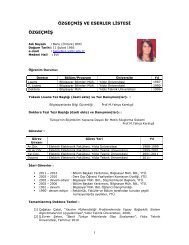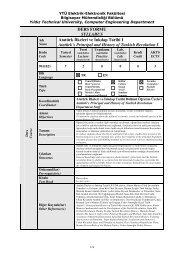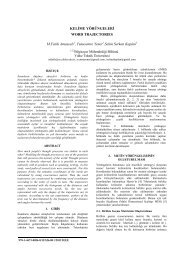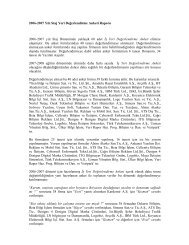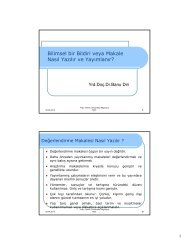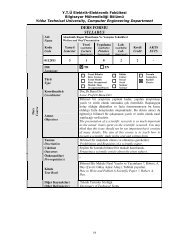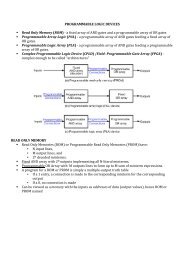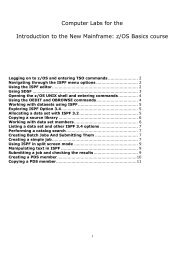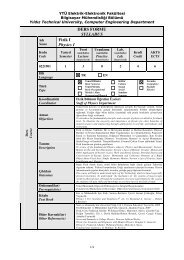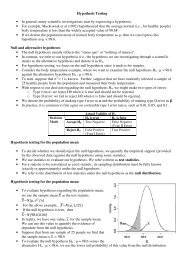A tutorial on Principal Components Analysis
A tutorial on Principal Components Analysis
A tutorial on Principal Components Analysis
You also want an ePaper? Increase the reach of your titles
YUMPU automatically turns print PDFs into web optimized ePapers that Google loves.
A <str<strong>on</strong>g>tutorial</str<strong>on</strong>g> <strong>on</strong> <strong>Principal</strong> Comp<strong>on</strong>ents <strong>Analysis</strong><br />
Lindsay I Smith<br />
February 26, 2002
Chapter 1<br />
Introducti<strong>on</strong><br />
This <str<strong>on</strong>g>tutorial</str<strong>on</strong>g> is designed to give the reader an understanding of <strong>Principal</strong> Comp<strong>on</strong>ents<br />
<strong>Analysis</strong> (PCA). PCA is a useful statistical technique that has found applicati<strong>on</strong> in<br />
fields such as face recogniti<strong>on</strong> and image compressi<strong>on</strong>, and is a comm<strong>on</strong> technique for<br />
finding patterns in data of high dimensi<strong>on</strong>.<br />
Before getting to a descripti<strong>on</strong> of PCA, this <str<strong>on</strong>g>tutorial</str<strong>on</strong>g> first introduces mathematical<br />
c<strong>on</strong>cepts that will be used in PCA. It covers standard deviati<strong>on</strong>, covariance, eigenvectors<br />
and eigenvalues. This background knowledge is meant to make the PCA secti<strong>on</strong><br />
very straightforward, but can be skipped if the c<strong>on</strong>cepts are already familiar.<br />
There are examples all the way through this <str<strong>on</strong>g>tutorial</str<strong>on</strong>g> that are meant to illustrate the<br />
c<strong>on</strong>cepts being discussed. If further informati<strong>on</strong> is required, the mathematics textbook<br />
“Elementary Linear Algebra 5e” by Howard Ant<strong>on</strong>, Publisher John Wiley & S<strong>on</strong>s Inc,<br />
ISBN 0-471-85223-6 is a good source of informati<strong>on</strong> regarding the mathematical background.<br />
1
Chapter 2<br />
Background Mathematics<br />
This secti<strong>on</strong> will attempt to give some elementary background mathematical skills that<br />
will be required to understand the process of <strong>Principal</strong> Comp<strong>on</strong>ents <strong>Analysis</strong>. The<br />
topics are covered independently of each other, and examples given. It is less important<br />
to remember the exact mechanics of a mathematical technique than it is to understand<br />
the reas<strong>on</strong> why such a technique may be used, and what the result of the operati<strong>on</strong> tells<br />
us about our data. Not all of these techniques are used in PCA, but the <strong>on</strong>es that are not<br />
explicitly required do provide the grounding <strong>on</strong> which the most important techniques<br />
are based.<br />
I have included a secti<strong>on</strong> <strong>on</strong> Statistics which looks at distributi<strong>on</strong> measurements,<br />
or, how the data is spread out. The other secti<strong>on</strong> is <strong>on</strong> Matrix Algebra and looks at<br />
eigenvectors and eigenvalues, important properties of matrices that are fundamental to<br />
PCA.<br />
2.1 Statistics<br />
The entire subject of statistics is based around the idea that you have this big set of data,<br />
and you want to analyse that set in terms of the relati<strong>on</strong>ships between the individual<br />
points in that data set. I am going to look at a few of the measures you can do <strong>on</strong> a set<br />
of data, and what they tell you about the data itself.<br />
2.1.1 Standard Deviati<strong>on</strong><br />
To understand standard deviati<strong>on</strong>, we need a data set. Statisticians are usually c<strong>on</strong>cerned<br />
with taking a sample of a populati<strong>on</strong>. To use electi<strong>on</strong> polls as an example, the<br />
populati<strong>on</strong> is all the people in the country, whereas a sample is a subset of the populati<strong>on</strong><br />
that the statisticians measure. The great thing about statistics is that by <strong>on</strong>ly<br />
measuring (in this case by doing a ph<strong>on</strong>e survey or similar) a sample of the populati<strong>on</strong>,<br />
you can work out what is most likely to be the measurement if you used the entire populati<strong>on</strong>.<br />
In this statistics secti<strong>on</strong>, I am going to assume that our data sets are samples<br />
2
¥<br />
<br />
¡ !"$# " <br />
<br />
of some bigger populati<strong>on</strong>. There is a reference later in this secti<strong>on</strong> pointing to more<br />
informati<strong>on</strong> about samples and populati<strong>on</strong>s.<br />
Here’s an example set:<br />
I could simply use the symbol to refer to this entire set of numbers. If I want to<br />
refer to an individual number in this data set, I will use subscripts <strong>on</strong> the symbol to<br />
indicate a specific number. Eg. refers to the 3rd number in , namely the number<br />
<br />
¢¡¤£¦¥¨§©¥§¥§©<br />
4. Note that is the first number in the sequence, not like you may see in some<br />
textbooks. Also, the symbol will be used to refer to the number of elements in the<br />
set<br />
There are a number of things that we can calculate about a data set. For example,<br />
we can calculate the mean of the sample. I assume that the reader understands what the<br />
mean of a sample is, and will <strong>on</strong>ly give the formula:<br />
Notice the symbol (said “X bar”) to indicate the mean of the set . All this formula<br />
says is “Add up all the numbers and then divide by how many there are”.<br />
Unfortunately, the mean doesn’t tell us a lot about the data except for a sort of<br />
middle point. For example, these two data sets have exactly the same mean (10), but<br />
are obviously quite different:<br />
£+,¥¥¥§<br />
So what is different about these two sets It is the spread of the data that is different.<br />
The Standard Deviati<strong>on</strong> (SD) of a data set is a measure of how spread out the data is.<br />
How do we calculate it The English definiti<strong>on</strong> of the SD is: “The average distance<br />
from the mean of the data set to a point”. The way to calculate it is to compute the<br />
squares of the distance from each data point to the mean of the set, add them all up,<br />
divide .- by , and take the positive square root. As a formula:<br />
*)<br />
£&%'¥&§§%(<br />
3254<br />
¡ !"$# 10 " -<br />
0 /<br />
-<br />
Where is the usual symbol for standard deviati<strong>on</strong> of a sample. I hear you asking “Why<br />
are you using 0 / ¥2<br />
and not ”. Well, the answer is a bit complicated, but in general,<br />
6-<br />
if your data set is a sample data set, ie. you have taken a subset of the real-world (like<br />
surveying 500 people about the electi<strong>on</strong>) then you must use 7-<br />
¥2<br />
because it turns out<br />
that this gives you an answer that is closer to the standard deviati<strong>on</strong> that would result<br />
if you had used the entire populati<strong>on</strong>, than if you’d used 0 . If, however, you are not<br />
<br />
calculating the standard deviati<strong>on</strong> for a sample, but for an entire populati<strong>on</strong>, then you<br />
should divide by instead of 8-<br />
¥2<br />
. For further reading <strong>on</strong> this topic, the web page<br />
http://mathcentral.uregina.ca/RR/database/RR.09.95/west<strong>on</strong>2.html describes standard<br />
deviati<strong>on</strong> in a similar way, and also provides an example experiment that shows the<br />
0<br />
¥2<br />
3
0<br />
0 :-<br />
-<br />
-<br />
Set 1:<br />
0 -10 100<br />
8 -2 4<br />
12 2 4<br />
20 10 100<br />
Total 208<br />
Divided by (n-1) 69.333<br />
Square Root 8.3266<br />
Set 2:<br />
0 " -<br />
32 0 " -<br />
32 4<br />
"<br />
8 -2 4<br />
9 -1 1<br />
11 1 1<br />
12 2 4<br />
Total 10<br />
Divided by (n-1) 3.333<br />
Square Root 1.8257<br />
Table 2.1: Calculati<strong>on</strong> of standard deviati<strong>on</strong><br />
difference between each of the denominators. It also discusses the difference between<br />
samples and populati<strong>on</strong>s.<br />
So, for our two data sets above, the calculati<strong>on</strong>s of standard deviati<strong>on</strong> are in Table<br />
2.1.<br />
And so, as expected, the first set has a much larger standard deviati<strong>on</strong> due to the<br />
fact that the data is much more spread out from the mean. Just as another example, the<br />
data set:<br />
£¦¥%¥%¥&%¥&%<br />
also has a mean of 10, but its standard deviati<strong>on</strong> is 0, because all the numbers are the<br />
same. N<strong>on</strong>e of them deviate from the mean.<br />
2.1.2 Variance<br />
Variance is another measure of the spread of data in a data set. In fact it is almost<br />
identical to the standard deviati<strong>on</strong>. The formula is this:<br />
32 4<br />
4 ¡ !"9# 0 " -<br />
¥2 /<br />
4
0 .-<br />
32 0 " -<br />
32 0 F " -<br />
You will notice that this is simply the standard deviati<strong>on</strong> squared, in both the symbol<br />
(<br />
4<br />
) and the formula (there is no square root in the formula for variance).<br />
/ 4<br />
is the<br />
usual symbol for variance of a sample. Both these measurements are measures of the<br />
spread of the data. Standard deviati<strong>on</strong> is the most comm<strong>on</strong> measure, but variance is<br />
/<br />
also used. The reas<strong>on</strong> why I have introduced variance in additi<strong>on</strong> to standard deviati<strong>on</strong><br />
is to provide a solid platform from which the next secti<strong>on</strong>, covariance, can launch from.<br />
Exercises<br />
Find the mean, standard deviati<strong>on</strong>, and variance for each of these data sets.<br />
[12 23 34 44 59 70 98]<br />
;<br />
[12 15 25 27 32 88 99]<br />
;<br />
;<br />
[15 35 78 82 90 95 97]<br />
2.1.3 Covariance<br />
The last two measures we have looked at are purely 1-dimensi<strong>on</strong>al. Data sets like this<br />
could be: heights of all the people in the room, marks for the last COMP101 exam etc.<br />
However many data sets have more than <strong>on</strong>e dimensi<strong>on</strong>, and the aim of the statistical<br />
analysis of these data sets is usually to see if there is any relati<strong>on</strong>ship between the<br />
dimensi<strong>on</strong>s. For example, we might have as our data set both the height of all the<br />
students in a class, and the mark they received for that paper. We could then perform<br />
statistical analysis to see if the height of a student has any effect <strong>on</strong> their mark.<br />
Standard deviati<strong>on</strong> and variance <strong>on</strong>ly operate <strong>on</strong> 1 dimensi<strong>on</strong>, so that you could<br />
<strong>on</strong>ly calculate the standard deviati<strong>on</strong> for each dimensi<strong>on</strong> of the data set independently<br />
of the other dimensi<strong>on</strong>s. However, it is useful to have a similar measure to find out how<br />
much the dimensi<strong>on</strong>s vary from the mean with respect to each other.<br />
Covariance is such a measure. Covariance is always measured between 2 dimensi<strong>on</strong>s.<br />
If you calculate the covariance between <strong>on</strong>e dimensi<strong>on</strong> and itself, you get the<br />
variance. So, if you had a 3-dimensi<strong>on</strong>al data set (< , = , > ), then you could measure the<br />
covariance between the < and = dimensi<strong>on</strong>s, the < and > dimensi<strong>on</strong>s, and the = and ><br />
dimensi<strong>on</strong>s. Measuring the covariance between < and < , or = and = , or > and > would<br />
give you the variance of the < , = and > dimensi<strong>on</strong>s respectively.<br />
The formula for covariance is very similar to the formula for variance. The formula<br />
for variance could also be written like this:<br />
A2<br />
(+@ 0 A2¨¡ !"9# 0 " -<br />
0 <br />
:-<br />
¥2<br />
where I have simply expanded the square term to show both parts. So given that knowledge,<br />
here is the formula for covariance:<br />
F2 <br />
B&CD 0 8E+F2G¡ !"9# 0 " -<br />
¥2<br />
5
F<br />
=<br />
2 E<br />
Q<br />
><br />
2 E<br />
I<br />
E<br />
2<br />
><br />
2 E<br />
<br />
includegraphicscovPlot.ps<br />
Figure 2.1: A plot of the covariance data showing positive relati<strong>on</strong>ship between the<br />
number of hours studied against the mark received<br />
It is exactly the same except that in the sec<strong>on</strong>d set of brackets, the<br />
’s are replaced by<br />
’s. This says, in English, “For each data item, multiply the difference between the <<br />
value and the mean < of , by the the difference between = the value and the mean = of .<br />
Add all these up, and divide by .-<br />
¥2<br />
”.<br />
0<br />
How does this work Lets use some example data. Imagine we have g<strong>on</strong>e into the<br />
world and collected some 2-dimensi<strong>on</strong>al data, say, we have asked a bunch of students<br />
how many hours in total that they spent studying COSC241, and the mark that they<br />
received. So we have two dimensi<strong>on</strong>s, the first is H the dimensi<strong>on</strong>, the hours studied,<br />
and the sec<strong>on</strong>d is I the dimensi<strong>on</strong>, the mark received. Figure 2.2 holds my imaginary<br />
data, and the calculati<strong>on</strong> of<br />
0 H , the covariance between the Hours of study<br />
d<strong>on</strong>e and the Mark received.<br />
So what does it tell us The exact value is not as important as it’s sign (ie. positive<br />
B&CD<br />
or negative). If the value is positive, as it is here, then that indicates that both dimensi<strong>on</strong>s<br />
increase together, meaning that, in general, as the number of hours of study<br />
increased, so did the final mark.<br />
If the value is negative, then as <strong>on</strong>e dimensi<strong>on</strong> increases, the other decreases. If we<br />
had ended up with a negative covariance here, then that would have said the opposite,<br />
that as the number of hours of study increased the the final mark decreased.<br />
In the last case, if the covariance is zero, it indicates that the two dimensi<strong>on</strong>s are<br />
independent of each other.<br />
The result that mark given increases as the number of hours studied increases can<br />
be easily seen by drawing a graph of the data, as in Figure 2.1.3. However, the luxury<br />
of being able to visualize data is <strong>on</strong>ly available at 2 and 3 dimensi<strong>on</strong>s. Since the covariance<br />
value can be calculated between any 2 dimensi<strong>on</strong>s in a data set, this technique<br />
is often used to find relati<strong>on</strong>ships between dimensi<strong>on</strong>s in high-dimensi<strong>on</strong>al data sets<br />
where visualisati<strong>on</strong> is difficult.<br />
You might ask “is B1CD 0 8E1F,2<br />
equal<br />
0 FJEK A2<br />
to ” Well, a quick look at the formula<br />
for covariance tells us that yes, they are exactly the same since the <strong>on</strong>ly difference<br />
B&CD 0 8E1F,2<br />
between and<br />
0 FLEM N2<br />
is that 0 " -<br />
A2 0 F " -<br />
F72<br />
is replaced by<br />
0 F B1CD <br />
B&CD F2 0 " -<br />
A2<br />
. And since multiplicati<strong>on</strong> is commutative, which means that it<br />
" -<br />
doesn’t matter which way around I multiply two numbers, I always get the same number,<br />
these two equati<strong>on</strong>s give the same answer.<br />
2.1.4 The covariance Matrix<br />
Recall that covariance is always measured between 2 dimensi<strong>on</strong>s. If we have a data set<br />
with more than 2 dimensi<strong>on</strong>s, there is more than <strong>on</strong>e covariance measurement that can<br />
be calculated. For example, from a 3 dimensi<strong>on</strong>al data set < (dimensi<strong>on</strong>s = , > , ) you<br />
could calculate<br />
0 < , 0 B&CD 0 < , and B&CD 0 = . In fact, for an -dimensi<strong>on</strong>al data<br />
B&CD<br />
set, you can calculate<br />
4 different covariance values.<br />
4DT<br />
!PO<br />
!SR<br />
O U<br />
6
H<br />
<br />
I<br />
<br />
H<br />
<br />
I<br />
2<br />
Hours(H) Mark(M)<br />
Data 9 39<br />
15 56<br />
25 93<br />
14 61<br />
10 50<br />
18 75<br />
0 32<br />
16 85<br />
5 42<br />
19 70<br />
16 66<br />
20 80<br />
Totals 167 749<br />
Averages 13.92 62.42<br />
Covariance:<br />
9 39 -4.92 -23.42 115.23<br />
15 56 1.08 -6.42 -6.93<br />
25 93 11.08 30.58 338.83<br />
14 61 0.08 -1.42 -0.11<br />
10 50 -3.92 -12.42 48.69<br />
18 75 4.08 12.58 51.33<br />
0 32 -13.92 -30.42 423.45<br />
16 85 2.08 22.58 46.97<br />
5 42 -8.92 -20.42 182.15<br />
19 70 5.08 7.58 38.51<br />
16 66 2.08 3.58 7.45<br />
20 80 6.08 17.58 106.89<br />
Total 1149.89<br />
Average 104.54<br />
H I 0 H " -<br />
2 0 I " -<br />
2 0 H " -<br />
2 0 I " -<br />
Table 2.2: 2-dimensi<strong>on</strong>al data set and covariance calculati<strong>on</strong><br />
7
V<br />
0 <<br />
E<br />
<<br />
2 B&CD 0 <<br />
E<br />
=<br />
2 B&CD 0 <<br />
E<br />
><br />
2<br />
B&CD<br />
0 =<br />
E<br />
<<br />
2 B&CD 0 =<br />
E<br />
=<br />
2 B&CD 0 =<br />
E<br />
><br />
2<br />
B&CD<br />
<<br />
E<br />
=<br />
E<br />
><br />
E<br />
A useful way to get all the possible covariance values between all the different<br />
dimensi<strong>on</strong>s is to calculate them all and put them in a matrix. I assume in this <str<strong>on</strong>g>tutorial</str<strong>on</strong>g><br />
that you are familiar with matrices, and how they can be defined. So, the definiti<strong>on</strong> for<br />
the covariance matrix for a set of data with dimensi<strong>on</strong>s is:<br />
¡ 0 B "MXY E B "ZXY ¡ B&CD 0M[]\_^ " E [`\Z^ Y 2a2ME<br />
where V !PWS! is a matrix with rows and columns, and [`\Z^b is the < th dimensi<strong>on</strong>.<br />
All that this ugly looking formula says is that if you have an -dimensi<strong>on</strong>al data set,<br />
then the matrix has rows and columns (so is square) and each entry in the matrix is<br />
the result of calculating the covariance between two separate dimensi<strong>on</strong>s. Eg. the entry<br />
<strong>on</strong> row 2, column 3, is the covariance value calculated between the 2nd dimensi<strong>on</strong> and<br />
the 3rd dimensi<strong>on</strong>.<br />
An example. We’ll make up the covariance matrix for an imaginary 3 dimensi<strong>on</strong>al<br />
data set, using the usual dimensi<strong>on</strong>s < , = and > . Then, the covariance matrix has 3 rows<br />
and 3 columns, and the values are this:<br />
!PWS!<br />
V ¡<br />
2<br />
Some points to note: Down the main diag<strong>on</strong>al, you see that the covariance value is<br />
between <strong>on</strong>e of the dimensi<strong>on</strong>s and itself. These are the variances for that dimensi<strong>on</strong>.<br />
B&CD 0 ><br />
2 B&CD 0 ><br />
The other point is that since B&CD 0 (¦E+c+2¨¡ B1CD 0 c&E1(P2<br />
main diag<strong>on</strong>al.<br />
2 B&CD 0 ><br />
, the matrix is symmetrical about the<br />
Exercises<br />
Work out the covariance between the < and = dimensi<strong>on</strong>s in the following 2 dimensi<strong>on</strong>al<br />
data set, and describe what the result indicates about the data.<br />
<<br />
=<br />
Item Number: 1 2 3 4 5<br />
10 39 19 23 28<br />
43 13 32 21 20<br />
Calculate the covariance matrix for this 3 dimensi<strong>on</strong>al set of data.<br />
<<br />
=<br />
><br />
Item Number: 1 2 3<br />
1 -1 4<br />
2 1 3<br />
1 3 -1<br />
2.2 Matrix Algebra<br />
This secti<strong>on</strong> serves to provide a background for the matrix algebra required in PCA.<br />
Specifically I will be looking at eigenvectors and eigenvalues of a given matrix. Again,<br />
I assume a basic knowledge of matrices.<br />
8
=<br />
¡<br />
¡g© f<br />
¡<br />
¥¥<br />
<br />
§ed<br />
¥ f §<br />
¥<br />
¡ d<br />
d<br />
§<br />
§ed<br />
¥ f §<br />
d§¡¥§<br />
<br />
Figure 2.2: Example of <strong>on</strong>e n<strong>on</strong>-eigenvector and <strong>on</strong>e eigenvector<br />
§ f<br />
d§¡ ©<br />
§ed<br />
¥ f §<br />
<br />
¡ ©<br />
§©<br />
¥<br />
¡g© f<br />
<br />
©<br />
Figure 2.3: Example of how a scaled eigenvector is still and eigenvector<br />
2.2.1 Eigenvectors<br />
As you know, you can multiply two matrices together, provided they are compatible<br />
sizes. Eigenvectors are a special case of this. C<strong>on</strong>sider the two multiplicati<strong>on</strong>s between<br />
a matrix and a vector in Figure 2.2.<br />
In the first example, the resulting vector is not an integer multiple of the original<br />
vector, whereas in the sec<strong>on</strong>d example, the example is exactly 4 times the vector we<br />
began with. Why is this Well, the vector is a vector in 2 dimensi<strong>on</strong>al space. The<br />
vector<br />
d<br />
(from the sec<strong>on</strong>d example multiplicati<strong>on</strong>) represents an arrow pointing<br />
§<br />
from the origin,<br />
%SEh%2<br />
, to the point 0 dSEh§2<br />
. The other matrix, the square <strong>on</strong>e, can be<br />
thought of as a transformati<strong>on</strong> matrix. If you multiply this matrix <strong>on</strong> the left of a<br />
vector, the answer is another vector that is transformed from it’s original positi<strong>on</strong>.<br />
0<br />
It is the nature of the transformati<strong>on</strong> that the eigenvectors arise from. Imagine a<br />
transformati<strong>on</strong> matrix that, when multiplied <strong>on</strong> the left, reflected vectors in the line<br />
. Then you can see that if there were a vector that lay <strong>on</strong> the line = < , it’s<br />
<<br />
reflecti<strong>on</strong> it itself. This vector (and all multiples of it, because it wouldn’t matter how<br />
l<strong>on</strong>g the vector was), would be an eigenvector of that transformati<strong>on</strong> matrix.<br />
What properties do these eigenvectors have You should first know that eigenvectors<br />
can <strong>on</strong>ly be found for square matrices. And, not every square matrix has eigenvectors.<br />
And, given f an matrix that does have eigenvectors, there are of them.<br />
Given a f d<br />
matrix, there are 3 eigenvectors.<br />
d<br />
Another property of eigenvectors is that even if I scale the vector by some amount<br />
before I multiply it, I still get the same multiple of it as a result, as in Figure 2.3. This<br />
is because if you scale a vector by some amount, all you are doing is making it l<strong>on</strong>ger,<br />
9
not changing it’s directi<strong>on</strong>. Lastly, all the eigenvectors of a matrix are perpendicular,<br />
ie. at right angles to each other, no matter how many dimensi<strong>on</strong>s you have. By the way,<br />
another word for perpendicular, in maths talk, is orthog<strong>on</strong>al. This is important because<br />
it means that you can express the data in terms of these perpendicular eigenvectors,<br />
instead of expressing them in terms of the < and = axes. We will be doing this later in<br />
the secti<strong>on</strong> <strong>on</strong> PCA.<br />
Another important thing to know is that when mathematicians find eigenvectors,<br />
they like to find the eigenvectors whose length is exactly <strong>on</strong>e. This is because, as you<br />
know, the length of a vector doesn’t affect whether it’s an eigenvector or not, whereas<br />
the directi<strong>on</strong> does. So, in order to keep eigenvectors standard, whenever we find an<br />
eigenvector we usually scale it to make it have a length of 1, so that all eigenvectors<br />
have the same length. Here’s a dem<strong>on</strong>strati<strong>on</strong> from our example above.<br />
d<br />
§<br />
is an eigenvector, and the length of that vector is<br />
0 d 4i § 4 2¨¡kj ¥ld<br />
so we divide the original vector by this much to make it have a length of 1.<br />
d<br />
m j ¥dn¡ §<br />
j ¥&d dSo<br />
j ¥&d §So<br />
How does <strong>on</strong>e go about finding these mystical eigenvectors Unfortunately, it’s<br />
<strong>on</strong>ly easy(ish) if you have a rather small matrix, like no bigger than about f d<br />
. After<br />
that, the usual way to find the eigenvectors is by some complicated iterative method<br />
which is bey<strong>on</strong>d the scope of this <str<strong>on</strong>g>tutorial</str<strong>on</strong>g> (and this author). If you ever need to find the<br />
d<br />
eigenvectors of a matrix in a program, just find a maths library that does it all for you.<br />
A useful maths package, called newmat, is available at http://webnz.com/robert/ .<br />
Further informati<strong>on</strong> about eigenvectors in general, how to find them, and orthog<strong>on</strong>ality,<br />
can be found in the textbook “Elementary Linear Algebra 5e” by Howard Ant<strong>on</strong>,<br />
Publisher John Wiley & S<strong>on</strong>s Inc, ISBN 0-471-85223-6.<br />
2.2.2 Eigenvalues<br />
Eigenvalues are closely related to eigenvectors, in fact, we saw an eigenvalue in Figure<br />
2.2. Notice how, in both those examples, the amount by which the original vector<br />
was scaled after multiplicati<strong>on</strong> by the square matrix was the same In that example,<br />
the value was 4. 4 is the eigenvalue associated with that eigenvector. No matter what<br />
multiple of the eigenvector we took before we multiplied it by the square matrix, we<br />
would always get 4 times the scaled vector as our result (as in Figure 2.3).<br />
So you can see that eigenvectors and eigenvalues always come in pairs. When you<br />
get a fancy programming library to calculate your eigenvectors for you, you usually get<br />
the eigenvalues as well.<br />
10
-<br />
¥<br />
-<br />
¥<br />
-<br />
-<br />
-<br />
¥<br />
-<br />
%<br />
¥<br />
Exercises<br />
For the following square matrix:<br />
d % ¥<br />
© ¥ §<br />
§<br />
Decide which, if any, of the following vectors are eigenvectors of that matrix and<br />
give the corresp<strong>on</strong>ding eigenvalue.<br />
p%<br />
§<br />
§<br />
%<br />
¥<br />
d<br />
§<br />
%<br />
§<br />
¥<br />
d<br />
11
Chapter 3<br />
<strong>Principal</strong> Comp<strong>on</strong>ents <strong>Analysis</strong><br />
Finally we come to <strong>Principal</strong> Comp<strong>on</strong>ents <strong>Analysis</strong> (PCA). What is it It is a way<br />
of identifying patterns in data, and expressing the data in such a way as to highlight<br />
their similarities and differences. Since patterns in data can be hard to find in data of<br />
high dimensi<strong>on</strong>, where the luxury of graphical representati<strong>on</strong> is not available, PCA is<br />
a powerful tool for analysing data.<br />
The other main advantage of PCA is that <strong>on</strong>ce you have found these patterns in the<br />
data, and you compress the data, ie. by reducing the number of dimensi<strong>on</strong>s, without<br />
much loss of informati<strong>on</strong>. This technique used in image compressi<strong>on</strong>, as we will see<br />
in a later secti<strong>on</strong>.<br />
This chapter will take you through the steps you needed to perform a <strong>Principal</strong><br />
Comp<strong>on</strong>ents <strong>Analysis</strong> <strong>on</strong> a set of data. I am not going to describe exactly why the<br />
technique works, but I will try to provide an explanati<strong>on</strong> of what is happening at each<br />
point so that you can make informed decisi<strong>on</strong>s when you try to use this technique<br />
yourself.<br />
3.1 Method<br />
Step 1: Get some data<br />
In my simple example, I am going to use my own made-up data set. It’s <strong>on</strong>ly got 2<br />
dimensi<strong>on</strong>s, and the reas<strong>on</strong> why I have chosen this is so that I can provide plots of the<br />
data to show what the PCA analysis is doing at each step.<br />
The data I have used is found in Figure 3.1, al<strong>on</strong>g with a plot of that data.<br />
Step 2: Subtract the mean<br />
For PCA to work properly, you have to subtract the mean from each of the data dimensi<strong>on</strong>s.<br />
The mean subtracted is the average across each dimensi<strong>on</strong>. So, all < the values<br />
have < (the mean of the < values of all the data points) subtracted, and all the = values<br />
have <br />
subtracted from them. This produces a data set whose mean is zero.<br />
=<br />
12
Data =<br />
x y<br />
2.5 2.4<br />
0.5 0.7<br />
2.2 2.9<br />
1.9 2.2<br />
3.1 3.0<br />
2.3 2.7<br />
2 1.6<br />
1 1.1<br />
1.5 1.6<br />
1.1 0.9<br />
DataAdjust =<br />
x y<br />
.69 .49<br />
-1.31 -1.21<br />
.39 .99<br />
.09 .29<br />
1.29 1.09<br />
.49 .79<br />
.19 -.31<br />
-.81 -.81<br />
-.31 -.31<br />
-.71 -1.01<br />
4<br />
Original PCA data<br />
"./PCAdata.dat"<br />
3<br />
2<br />
1<br />
0<br />
-1<br />
-1 0 1 2 3 4<br />
Figure 3.1: PCA example data, original data <strong>on</strong> the left, data with the means subtracted<br />
<strong>on</strong> the right, and a plot of the data<br />
13
¡ q r¥ q r¥©©©©©©<br />
B&CD r¥©©©©©© q ¥<br />
q<br />
Step 3: Calculate the covariance matrix<br />
This is d<strong>on</strong>e in exactly the same way as was discussed in secti<strong>on</strong> 2.1.4. Since the data<br />
is 2 dimensi<strong>on</strong>al, the covariance matrix will be f §<br />
. There are no surprises here, so I<br />
will just give you the result:<br />
§<br />
So, since the n<strong>on</strong>-diag<strong>on</strong>al elements in this covariance matrix are positive, we should<br />
expect that both the < and = variable increase together.<br />
Step 4: Calculate the eigenvectors and eigenvalues of the covariance<br />
matrix<br />
Since the covariance matrix is square, we can calculate the eigenvectors and eigenvalues<br />
for this matrix. These are rather important, as they tell us useful informati<strong>on</strong> about<br />
our data. I will show you why so<strong>on</strong>. In the meantime, here are the eigenvectors and<br />
eigenvalues:<br />
s \Zt s (¦uwv sx/ ¡<br />
%©%dd<br />
¥ q §©%§¥ q<br />
r&dd<br />
- q d¥&<br />
q<br />
It is important to notice that these eigenvectors are both unit eigenvectors ie. their<br />
lengths are both 1. This is very important for PCA, but luckily, most maths packages,<br />
when asked for eigenvectors, will give you unit eigenvectors.<br />
So what do they mean If you look at the plot of the data in Figure 3.2 then you can<br />
see how the data has quite a str<strong>on</strong>g pattern. As expected from the covariance matrix,<br />
they two variables do indeed increase together. On top of the data I have plotted both<br />
the eigenvectors as well. They appear as diag<strong>on</strong>al dotted lines <strong>on</strong> the plot. As stated<br />
in the eigenvector secti<strong>on</strong>, they are perpendicular to each other. But, more importantly,<br />
they provide us with informati<strong>on</strong> about the patterns in the data. See how <strong>on</strong>e of the<br />
eigenvectors goes through the middle of the points, like drawing a line of best fit That<br />
eigenvector is showing us how these two data sets are related al<strong>on</strong>g that line. The<br />
sec<strong>on</strong>d eigenvector gives us the other, less important, pattern in the data, that all the<br />
points follow the main line, but are off to the side of the main line by some amount.<br />
So, by this process of taking the eigenvectors of the covariance matrix, we have<br />
been able to extract lines that characterise the data. The rest of the steps involve transforming<br />
the data so that it is expressed in terms of them lines.<br />
s \_t s rsyBZz1C @ / ¡<br />
- q d¥<br />
- q &dd<br />
Step 5: Choosing comp<strong>on</strong>ents and forming a feature vector<br />
Here is where the noti<strong>on</strong> of data compressi<strong>on</strong> and reduced dimensi<strong>on</strong>ality comes into<br />
it. If you look at the eigenvectors and eigenvalues from the previous secti<strong>on</strong>, you<br />
14
2<br />
1.5<br />
Mean adjusted data with eigenvectors overlayed<br />
"PCAdataadjust.dat"<br />
(-.740682469/.671855252)*x<br />
(-.671855252/-.740682469)*x<br />
1<br />
0.5<br />
0<br />
-0.5<br />
-1<br />
-1.5<br />
-2<br />
-2 -1.5 -1 -0.5 0 0.5 1 1.5 2<br />
Figure 3.2: A plot of the normalised data (mean subtracted) with the eigenvectors of<br />
the covariance matrix overlayed <strong>on</strong> top.<br />
15
!<br />
will notice that the eigenvalues are quite different values. In fact, it turns out that<br />
the eigenvector with the highest eigenvalue is the principle comp<strong>on</strong>ent of the data set.<br />
In our example, the eigenvector with the larges eigenvalue was the <strong>on</strong>e that pointed<br />
down the middle of the data. It is the most significant relati<strong>on</strong>ship between the data<br />
dimensi<strong>on</strong>s.<br />
In general, <strong>on</strong>ce eigenvectors are found from the covariance matrix, the next step<br />
is to order them by eigenvalue, highest to lowest. This gives you the comp<strong>on</strong>ents in<br />
order of significance. Now, if you like, you can decide to ignore the comp<strong>on</strong>ents of<br />
lesser significance. You do lose some informati<strong>on</strong>, but if the eigenvalues are small, you<br />
d<strong>on</strong>’t lose much. If you leave out some comp<strong>on</strong>ents, the final data set will have less<br />
dimensi<strong>on</strong>s than the original. To be precise, if you originally have dimensi<strong>on</strong>s in<br />
your data, and so you calculate eigenvectors and eigenvalues, and then you choose<br />
<strong>on</strong>ly the first { eigenvectors, then the final data set has <strong>on</strong>ly { dimensi<strong>on</strong>s.<br />
What needs to be d<strong>on</strong>e now is you need to form a feature vector, which is just<br />
a fancy name for a matrix of vectors. This is c<strong>on</strong>structed by taking the eigenvectors<br />
that you want to keep from the list of eigenvectors, and forming a matrix with these<br />
eigenvectors in the columns.<br />
2<br />
Given our example set of data, and the fact that we have 2 eigenvectors, we have<br />
two choices. We can either form a feature vector with both of the eigenvectors:<br />
| s ( z v@ sy}~syBZz1C @n¡ 0 s \Zt s \Zt 4 s \Zt <br />
qq€q€q s \Zt<br />
- q &dr¥ q &dd<br />
or, we can choose to leave out the smaller, less significant comp<strong>on</strong>ent and <strong>on</strong>ly have a<br />
single column:<br />
- q &dd<br />
- q r&dd<br />
- q &d¥<br />
- q d¥&<br />
We shall see the result of each of these in the next secti<strong>on</strong>.<br />
Step 5: Deriving the new data set<br />
This the final step in PCA, and is also the easiest. Once we have chosen the comp<strong>on</strong>ents<br />
(eigenvectors) that we wish to keep in our data and formed a feature vector, we simply<br />
take the transpose of the vector and multiply it <strong>on</strong> the left of the original data set,<br />
transposed.<br />
CD‚ | s ( z v†@ sy}6syBZz1C @<br />
where<br />
is the matrix with the eigenvectors in the columns transposed<br />
so that the eigenvectors are now in the rows, with the most significant eigenvector<br />
at the top,<br />
CD‚ [ ( z (¦ƒ<br />
)…„<br />
v /hz<br />
and<br />
is the mean-adjusted data transposed, ie. the data<br />
items are in each column, with each row holding a separate dimensi<strong>on</strong>. I’m sorry if<br />
this sudden transpose of all our data c<strong>on</strong>fuses you, but the equati<strong>on</strong>s from here <strong>on</strong> are<br />
)…„<br />
CD‚ [ ( z (¦ƒ<br />
v /hz E<br />
| \ <br />
(¦u [ ( z (6¡k CD‚ | s ( z v@ sx}7syBZz1C @ f<br />
16
easier if we take the transpose of the feature vector and the data first, rather that having<br />
is the final data set, with<br />
a little T symbol above their names from now <strong>on</strong>.<br />
\ <br />
(¦u [ ( z (<br />
data items in columns, and dimensi<strong>on</strong>s al<strong>on</strong>g rows.<br />
What will this give us It will give us the original data solely in terms of the vectors<br />
|<br />
we chose. Our original data set had two < axes, = and , so our data was in terms of<br />
them. It is possible to express data in terms of any two axes that you like. If these<br />
axes are perpendicular, then the expressi<strong>on</strong> is the most efficient. This was why it was<br />
important that eigenvectors are always perpendicular to each other. We have changed<br />
our data from being in terms of the < axes = and , and now they are in terms of our 2<br />
eigenvectors. In the case of when the new data set has reduced dimensi<strong>on</strong>ality, ie. we<br />
have left some of the eigenvectors out, the new data is <strong>on</strong>ly in terms of the vectors that<br />
we decided to keep.<br />
To show this <strong>on</strong> our data, I have d<strong>on</strong>e the final transformati<strong>on</strong> with each of the<br />
possible feature vectors. I have taken the transpose of the result in each case to bring<br />
the data back to the nice table-like format. I have also plotted the final points to show<br />
how they relate to the comp<strong>on</strong>ents.<br />
In the case of keeping both eigenvectors for the transformati<strong>on</strong>, we get the data and<br />
the plot found in Figure 3.3. This plot is basically the original data, rotated so that the<br />
eigenvectors are the axes. This is understandable since we have lost no informati<strong>on</strong> in<br />
this decompositi<strong>on</strong>.<br />
The other transformati<strong>on</strong> we can make is by taking <strong>on</strong>ly the eigenvector with the<br />
largest eigenvalue. The table of data resulting from that is found in Figure 3.4. As<br />
expected, it <strong>on</strong>ly has a single dimensi<strong>on</strong>. If you compare this data set with the <strong>on</strong>e<br />
resulting from using both eigenvectors, you will notice that this data set is exactly the<br />
first column of the other. So, if you were to plot this data, it would be 1 dimensi<strong>on</strong>al,<br />
and would be points <strong>on</strong> a line in exactly < the positi<strong>on</strong>s of the points in the plot in<br />
Figure 3.3. We have effectively thrown away the whole other axis, which is the other<br />
eigenvector.<br />
So what have we d<strong>on</strong>e here Basically we have transformed our data so that is<br />
expressed in terms of the patterns between them, where the patterns are the lines that<br />
most closely describe the relati<strong>on</strong>ships between the data. This is helpful because we<br />
have now classified our data point as a combinati<strong>on</strong> of the c<strong>on</strong>tributi<strong>on</strong>s from each of<br />
those lines. Initially we had the < simple = and axes. This is fine, but < the = and<br />
values of each data point d<strong>on</strong>’t really tell us exactly how that point relates to the rest of<br />
the data. Now, the values of the data points tell us exactly where (ie. above/below) the<br />
trend lines the data point sits. In the case of the transformati<strong>on</strong> using both eigenvectors,<br />
we have simply altered the data so that it is in terms of those eigenvectors instead of<br />
the usual axes. But the single-eigenvector decompositi<strong>on</strong> has removed the c<strong>on</strong>tributi<strong>on</strong><br />
due to the smaller eigenvector and left us with data that is <strong>on</strong>ly in terms of the other.<br />
3.1.1 Getting the old data back<br />
Wanting to get the original data back is obviously of great c<strong>on</strong>cern if you are using<br />
the PCA transform for data compressi<strong>on</strong> (an example of which to will see in the next<br />
secti<strong>on</strong>). This c<strong>on</strong>tent is taken from<br />
http://www.visi<strong>on</strong>.auc.dk/ sig/Teaching/Flerdim/Current/hotelling/hotelling.html<br />
17
Transformed Data=<br />
= <<br />
-.827970186 -.175115307<br />
1.77758033 .142857227<br />
-.992197494 .384374989<br />
-.274210416 .130417207<br />
-1.67580142 -.209498461<br />
-.912949103 .175282444<br />
.0991094375 -.349824698<br />
1.14457216 .0464172582<br />
.438046137 .0177646297<br />
1.22382056 -.162675287<br />
2<br />
Data transformed with 2 eigenvectors<br />
"./doublevecfinal.dat"<br />
1.5<br />
1<br />
0.5<br />
0<br />
-0.5<br />
-1<br />
-1.5<br />
-2<br />
-2 -1.5 -1 -0.5 0 0.5 1 1.5 2<br />
Figure 3.3: The table of data by applying the PCA analysis using both eigenvectors,<br />
and a plot of the new data points.<br />
18
R<br />
<br />
R<br />
<br />
Transformed Data (Single eigenvector)<br />
<<br />
-.827970186<br />
1.77758033<br />
-.992197494<br />
-.274210416<br />
-1.67580142<br />
-.912949103<br />
.0991094375<br />
1.14457216<br />
.438046137<br />
1.22382056<br />
Figure 3.4: The data after transforming using <strong>on</strong>ly the most significant eigenvector<br />
So, how do we get the original data back Before we do that, remember that <strong>on</strong>ly if<br />
we took all the eigenvectors in our transformati<strong>on</strong> will we get exactly the original data<br />
back. If we have reduced the number of eigenvectors in the final transformati<strong>on</strong>, then<br />
the retrieved data has lost some informati<strong>on</strong>.<br />
Recall that the final transform is this:<br />
which can be turned around so that, to get the original data back,<br />
| \ <br />
(¦u [ ( z (6¡k CD‚ | s ( z v@ sx}7syBZz1C @ f<br />
)…„<br />
CD‚ [ ( z (¦ƒ<br />
v /hz E<br />
CD‚ | s ( z v†@ sy}6syBZz1C @<br />
where<br />
is the inverse<br />
CD‚ | s ( z v@ sx}7syBZz1C @<br />
of<br />
. However, when<br />
we take all the eigenvectors in our feature vector, it turns out that the inverse of our<br />
feature vector is actually equal to the transpose of our feature vector. This is <strong>on</strong>ly true<br />
because the elements of the matrix are all the unit eigenvectors of our data set. This<br />
makes the return trip to our data easier, because the equati<strong>on</strong> becomes<br />
CD‚ [ ( z (¦ƒ<br />
v /hz ¡ˆ CD‚ | s ( z v@ sx}7syBZz1C @<br />
(¦u [ ( z (<br />
)‡„<br />
f | \ <br />
(¦u [ ( z (<br />
)…„<br />
But, to get the actual original data back, we need to add <strong>on</strong> the mean of that original<br />
data (remember we subtracted it right at the start). So, for completeness,<br />
CD‚ [ ( z (¦ƒ<br />
v /hz ¡ˆ CD‚ | s ( z v@ sy}7sxBMz1C @‰ f | \ <br />
<br />
This formula also applies to when you do not have all the eigenvectors in the feature<br />
vector. So even when you leave out some eigenvectors, the above equati<strong>on</strong> still makes<br />
the correct transform.<br />
I will not perform the data re-creati<strong>on</strong> using the complete feature vector, because the<br />
result is exactly the data we started with. However, I will do it with the reduced feature<br />
vector to show you how informati<strong>on</strong> has been lost. Figure 3.5 show this plot. Compare<br />
CD‚7Š @ \Zt‹\ <br />
CD‚ | s ( z v@ sy}6syBZz1C @‰ f | \ <br />
(‹u [ ( z (P2 i Š @ \Zt\ <br />
I s (<br />
(¦u [ ( z (7¡ 0<br />
(¦u<br />
19
4<br />
Original data restored using <strong>on</strong>ly a single eigenvector<br />
"./lossyplusmean.dat"<br />
3<br />
2<br />
1<br />
0<br />
-1<br />
-1 0 1 2 3 4<br />
Figure 3.5: The rec<strong>on</strong>structi<strong>on</strong> from the data that was derived using <strong>on</strong>ly a single eigenvector<br />
it to the original data plot in Figure 3.1 and you will notice how, while the variati<strong>on</strong><br />
al<strong>on</strong>g the principle eigenvector (see Figure 3.2 for the eigenvector overlayed <strong>on</strong> top of<br />
the mean-adjusted data) has been kept, the variati<strong>on</strong> al<strong>on</strong>g the other comp<strong>on</strong>ent (the<br />
other eigenvector that we left out) has g<strong>on</strong>e.<br />
Exercises<br />
What do the eigenvectors of the covariance matrix give us<br />
;<br />
At what point in the PCA process can we decide to compress the data What<br />
;<br />
effect does this have<br />
For an example of PCA and a graphical representati<strong>on</strong> of the principal eigenvectors,<br />
research the topic ’Eigenfaces’, which uses PCA to do facial<br />
;<br />
recogniti<strong>on</strong><br />
20
¡<br />
<<br />
<br />
<br />
4<br />
Chapter 4<br />
Applicati<strong>on</strong> to Computer Visi<strong>on</strong><br />
This chapter will outline the way that PCA is used in computer visi<strong>on</strong>, first showing<br />
how images are usually represented, and then showing what PCA can allow us to do<br />
with those images. The informati<strong>on</strong> in this secti<strong>on</strong> regarding facial recogniti<strong>on</strong> comes<br />
from “Face Recogniti<strong>on</strong>: Eigenface, Elastic Matching, and Neural Nets”, Jun Zhang et<br />
al. Proceedings of the IEEE, Vol. 85, No. 9, September 1997. The representati<strong>on</strong> informati<strong>on</strong>,<br />
is taken from “Digital Image Processing” Rafael C. G<strong>on</strong>zalez and Paul Wintz,<br />
Addis<strong>on</strong>-Wesley Publishing Company, 1987. It is also an excellent reference for further<br />
informati<strong>on</strong> <strong>on</strong> the K-L transform in general. The image compressi<strong>on</strong> informati<strong>on</strong> is<br />
taken from http://www.visi<strong>on</strong>.auc.dk/ sig/Teaching/Flerdim/Current/hotelling/hotelling.html,<br />
which also provides examples of image rec<strong>on</strong>structi<strong>on</strong> using a varying amount of eigenvectors.<br />
4.1 Representati<strong>on</strong><br />
When using these sort of matrix techniques in computer visi<strong>on</strong>, we must c<strong>on</strong>sider repre-<br />
-dimensi<strong>on</strong>al<br />
vector<br />
sentati<strong>on</strong> of images. A square, Œ by Œ image can be expressed as an Œ<br />
where the rows of pixels in the image are placed <strong>on</strong>e after the other to form a <strong>on</strong>edimensi<strong>on</strong>al<br />
image. E.g. The first Πelements (<<br />
q q < Ž‘<br />
image, the Πnext elements are the next row, and so <strong>on</strong>. The values in the vector are<br />
the intensity values of the image, possibly a single greyscale value.<br />
-g< Ž will be the first row of the<br />
< 4 <<br />
4.2 PCA to find patterns<br />
Say we have 20 images. Each image is Πpixels high by Πpixels wide. For each<br />
image we can create an image vector as described in the representati<strong>on</strong> secti<strong>on</strong>. We<br />
can then put all the images together in <strong>on</strong>e big image-matrix like this:<br />
21
’ ^ ( t sx/ I<br />
4<br />
( z @ \ <<br />
¡<br />
q<br />
’ ^ ( t<br />
q §% sy}~syB<br />
4<br />
4<br />
4<br />
^ ( t sx}6sxB ¥ ’<br />
^ ( t sx}6sxB § ’<br />
which gives us a starting point for our PCA analysis. Once we have performed PCA,<br />
we have our original data in terms of the eigenvectors we found from the covariance<br />
matrix. Why is this useful Say we want to do facial recogniti<strong>on</strong>, and so our original<br />
images were of peoples faces. Then, the problem is, given a new image, whose face<br />
from the original set is it (Note that the new image is not <strong>on</strong>e of the 20 we started<br />
with.) The way this is d<strong>on</strong>e is computer visi<strong>on</strong> is to measure the difference between<br />
the new image and the original images, but not al<strong>on</strong>g the original axes, al<strong>on</strong>g the new<br />
axes derived from the PCA analysis.<br />
It turns out that these axes works much better for recognising faces, because the<br />
PCA analysis has given us the original images in terms of the differences and similarities<br />
between them. The PCA analysis has identified the statistical patterns in the<br />
data.<br />
Since all the vectors Πare dimensi<strong>on</strong>al, we will Πget eigenvectors. In practice,<br />
we are able to leave out some of the less significant eigenvectors, and the recogniti<strong>on</strong><br />
still performs well.<br />
4.3 PCA for image compressi<strong>on</strong><br />
Using PCA for image compressi<strong>on</strong> also know as the Hotelling, or Karhunen and Leove<br />
(KL), transform. If we have 20 images, each Πwith pixels, we can Πform vectors,<br />
each with 20 dimensi<strong>on</strong>s. Each vector c<strong>on</strong>sists of all the intensity values from the same<br />
pixel from each picture. This is different from the previous example because before we<br />
had a vector for image, and each item in that vector was a different pixel, whereas now<br />
we have a vector for each pixel, and each item in the vector is from a different image.<br />
Now we perform the PCA <strong>on</strong> this set of data. We will get 20 eigenvectors because<br />
each vector is 20-dimensi<strong>on</strong>al. To compress the data, we can then choose to transform<br />
the data <strong>on</strong>ly using, say 15 of the eigenvectors. This gives us a final data set with<br />
<strong>on</strong>ly 15 dimensi<strong>on</strong>s, which has saved us of the space. However, when the original<br />
data is reproduced, the images have lost some of the informati<strong>on</strong>. This compressi<strong>on</strong><br />
technique is said to be lossy because the decompressed image is not exactly the same<br />
¥“o1©<br />
as the original, generally worse.<br />
22
Appendix A<br />
Implementati<strong>on</strong> Code<br />
This is code for use in Scilab, a freeware alternative to Matlab. I used this code to<br />
generate all the examples in the text. Apart from the first macro, all the rest were<br />
written by me.<br />
// This macro taken from<br />
// http://www.cs.m<strong>on</strong>tana.edu/˜harkin/courses/cs530/scilab/macros/cov.sci<br />
// No alterati<strong>on</strong>s made<br />
// Return the covariance matrix of the data in x, where each column of x<br />
// is <strong>on</strong>e dimensi<strong>on</strong> of an n-dimensi<strong>on</strong>al data set. That is, x has x columns<br />
// and m rows, and each row is <strong>on</strong>e sample.<br />
//<br />
// For example, if x is three dimensi<strong>on</strong>al and there are 4 samples.<br />
// x = [1 2 3;4 5 6;7 8 9;10 11 12]<br />
// c = cov (x)<br />
functi<strong>on</strong> [c]=cov (x)<br />
// Get the size of the array<br />
sizex=size(x);<br />
// Get the mean of each column<br />
meanx = mean (x, "r");<br />
// For each pair of variables, x1, x2, calculate<br />
// sum ((x1 - meanx1)(x2-meanx2))/(m-1)<br />
for var = 1:sizex(2),<br />
x1 = x(:,var);<br />
mx1 = meanx (var);<br />
for ct = var:sizex (2),<br />
x2 = x(:,ct);<br />
mx2 = meanx (ct);<br />
v = ((x1 - mx1)’ * (x2 - mx2))/(sizex(1) - 1);<br />
23
end,<br />
c=cv;<br />
end,<br />
cv(var,ct) = v;<br />
cv(ct,var) = v;<br />
// do the lower part of c also.<br />
// This a simple wrapper functi<strong>on</strong> to get just the eigenvectors<br />
// since the system call returns 3 matrices<br />
functi<strong>on</strong> [x]=justeigs (x)<br />
// This just returns the eigenvectors of the matrix<br />
[a, eig, b] = bdiag(x);<br />
x= eig;<br />
// this functi<strong>on</strong> makes the transformati<strong>on</strong> to the eigenspace for PCA<br />
// parameters:<br />
// adjusteddata = mean-adjusted data set<br />
// eigenvectors = SORTED eigenvectors (by eigenvalue)<br />
// dimensi<strong>on</strong>s = how many eigenvectors you wish to keep<br />
//<br />
// The first two parameters can come from the result of calling<br />
// PCAprepare <strong>on</strong> your data.<br />
// The last is up to you.<br />
functi<strong>on</strong> [finaldata] = PCAtransform(adjusteddata,eigenvectors,dimensi<strong>on</strong>s)<br />
finaleigs = eigenvectors(:,1:dimensi<strong>on</strong>s);<br />
prefinaldata = finaleigs’*adjusteddata’;<br />
finaldata = prefinaldata’;<br />
// This functi<strong>on</strong> does the preparati<strong>on</strong> for PCA analysis<br />
// It adjusts the data to subtract the mean, finds the covariance matrix,<br />
// and finds normal eigenvectors of that covariance matrix.<br />
// It returns 4 matrices<br />
// meanadjust = the mean-adjust data set<br />
// covmat = the covariance matrix of the data<br />
// eigvalues = the eigenvalues of the covariance matrix, IN SORTED ORDER<br />
// normaleigs = the normalised eigenvectors of the covariance matrix,<br />
// IN SORTED ORDER WITH RESPECT TO<br />
// THEIR EIGENVALUES, for selecti<strong>on</strong> for the feature vector.<br />
24
// NOTE: This functi<strong>on</strong> cannot handle data sets that have any eigenvalues<br />
// equal to zero. It’s got something to do with the way that scilab treats<br />
// the empty matrix and zeros.<br />
//<br />
functi<strong>on</strong> [meanadjusted,covmat,sorteigvalues,sortnormaleigs] = PCAprepare (data)<br />
// Calculates the mean adjusted matrix, <strong>on</strong>ly for 2 dimensi<strong>on</strong>al data<br />
means = mean(data,"r");<br />
meanadjusted = meanadjust(data);<br />
covmat = cov(meanadjusted);<br />
eigvalues = spec(covmat);<br />
normaleigs = justeigs(covmat);<br />
sorteigvalues = sorteigvectors(eigvalues’,eigvalues’);<br />
sortnormaleigs = sorteigvectors(eigvalues’,normaleigs);<br />
// This removes a specified column from a matrix<br />
// A = the matrix<br />
// n = the column number you wish to remove<br />
functi<strong>on</strong> [columnremoved] = removecolumn(A,n)<br />
inputsize = size(A);<br />
numcols = inputsize(2);<br />
temp = A(:,1:(n-1));<br />
for var = 1:(numcols - n)<br />
temp(:,(n+var)-1) = A(:,(n+var));<br />
end,<br />
columnremoved = temp;<br />
// This finds the column number that has the<br />
// highest value in it’s first row.<br />
functi<strong>on</strong> [column] = highestvalcolumn(A)<br />
inputsize = size(A);<br />
numcols = inputsize(2);<br />
maxval = A(1,1);<br />
maxcol = 1;<br />
for var = 2:numcols<br />
if A(1,var) > maxval<br />
maxval = A(1,var);<br />
maxcol = var;<br />
end,<br />
end,<br />
column = maxcol<br />
25
This sorts a matrix of vectors, based <strong>on</strong> the values of<br />
// another matrix<br />
//<br />
// values = the list of eigenvalues (1 per column)<br />
// vectors = The list of eigenvectors (1 per column)<br />
//<br />
// NOTE: The values should corresp<strong>on</strong>d to the vectors<br />
// so that the value in column x corresp<strong>on</strong>ds to the vector<br />
// in column x.<br />
functi<strong>on</strong> [sortedvecs] = sorteigvectors(values,vectors)<br />
inputsize = size(values);<br />
numcols = inputsize(2);<br />
highcol = highestvalcolumn(values);<br />
sorted = vectors(:,highcol);<br />
remainvec = removecolumn(vectors,highcol);<br />
remainval = removecolumn(values,highcol);<br />
for var = 2:numcols<br />
highcol = highestvalcolumn(remainval);<br />
sorted(:,var) = remainvec(:,highcol);<br />
remainvec = removecolumn(remainvec,highcol);<br />
remainval = removecolumn(remainval,highcol);<br />
end,<br />
sortedvecs = sorted;<br />
// This takes a set of data, and subtracts<br />
// the column mean from each column.<br />
functi<strong>on</strong> [meanadjusted] = meanadjust(Data)<br />
inputsize = size(Data);<br />
numcols = inputsize(2);<br />
means = mean(Data,"r");<br />
tmpmeanadjusted = Data(:,1) - means(:,1);<br />
for var = 2:numcols<br />
tmpmeanadjusted(:,var) = Data(:,var) - means(:,var);<br />
end,<br />
meanadjusted = tmpmeanadjusted<br />
26



